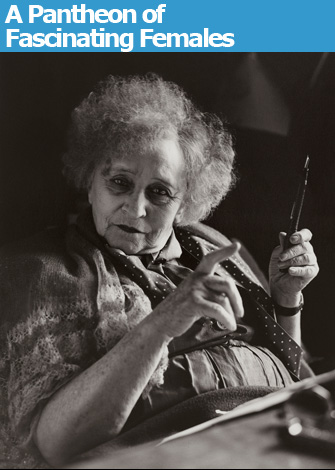 |
|
Colette in her Palais Royal apartment in Paris, 1953. Photo by Janine Niepce. © Janine Niepce / Bibliothèque Marguerite Durand / Roger-Viollet |
 |
|
Colette in her Palais Royal apartment in Paris, 1953. Photo by Janine Niepce. © Janine Niepce / Bibliothèque Marguerite Durand / Roger-Viollet |
It may seem that feminism was born in the 1960s with the bra burners of the Women’s Lib movement, but in fact it has a long and illustrious history, even in France, a country where women did not get the right to vote until 1944 and where, even today, it sometimes seems that women are second-class citizens (the sexism in the much-lauded film Le Nom des Gens, for example, went unnoticed by both critics and spectators).
Let’s not forget, however, that women’s rights were a hot topic of the French Enlightenment and were championed by the likes of the distinguished 18th-century philosopher and statesman the Marquis de Cordorcet, supporter of the Revolution (and eventually one of its victims). And, of course, The Second Sex, arguably the 20th-century’s seminal book on feminism, was written by a Frenchwoman, Simone de Beauvoir.
Which brings us to the great new exhibition at the Galerie des Bibliothèques, “Photo, Femmes, Féminisme.” Through its presentation of the photo collection of the Bibliothèque Marguerite Durand, it offers a fascinating and entertaining history of the French women’s movement over the past 150 years.
It begins with the story of Marguerite Durand (1864-1936), a star of the Comédie Française before her career was interrupted by a short-lived marriage to a journalist, which had the side effect of getting her interested in politics and journalism. Once again single, she founded in 1897 a daily newspaper called La Fronde, whose very existence she saw as a “militant act of feminism,” since everyone involved in its production, from the editors and writers to the typesetters, was a woman. Its stance was pro-women’s rights, of course, pro-Dreyfus, republican (as opposed to royalist) and secular. The women associated with La Fronde (which means “revolt”), seen in photographic portraits, were pioneering, free-thinking (many were Freemasons) doctors, lawyers, philosophers, journalists and other professionals. This first part of the show also includes images of Belle Epoque public demonstrations for women’s suffrage, including one honoring the above-mentioned Condorcet.
The always elegant Durand, who ran for political office and encouraged other women to do so even though they couldn’t vote, believed that women should always dress well, “if only to take away from superficial men the argument that feminism is the enemy of good taste and a feminine aesthetic.”
La Fronde’s short life came to an end in 1905, and in 1932 Durand donated her library to the city of Paris, where it still exists (although it has moved from the 5th arrondissement to the 13th) and is still devoted to the history of women and of feminism. Over the years, the library has built a large collection of photos focusing on the struggle for women’s rights in France, and some 200 of them are presented in the show, which continues downstairs and covers – in addition to the Belle Epoque feminists – female personalities, women working in traditionally male jobs, women’s involvement in political struggles and images by women photographers.
The most gripping section of the show is the one on female luminaries in the worlds of art, theater and literature. Each photo of these personalities – some of them, like Sarah Bernhardt, Josephine Baker and Colette, very familiar to us and others less so – is accompanied by a short biographical text (in French only). Among them are many irresistible eccentrics, and any biographer searching for an interesting subject would do well to look here. There are forgotten composers like Augusta Holmès, forgotten painters like Clémentine-Hélène Dufau, and extravagant characters like Queen Elisabeth of Romania (1843-1916), a.k.a. Carmen Sylva, a multilingual Jane of all literary arts who wrote poems, plays, novels, short stories, essays and collections of aphorisms. She was also privately pro-republican, not a common position for a queen.
Some of this pantheon of fascinating women liked to dress as men. One of the most extreme was the writer Marc de Montifaud (1850-1912), née Marie Amélie Chartoule, a free-thinking writer who was married to a count, had a son, but who dressed and lived as a man, and even did time in prison for her erotic writing. Another confirmed cross-dresser was the explorer Jane Dieulafoy, a conservative anti-feminist except when it came to the issue of allowing women to serve in the army, which she enthusiastically supported.
The exhibition reminds us that the struggle isn’t over yet while providing plenty of inspiration for keeping up the fight. After learning so much about how hard-won the right to vote was, you might just want to cheer when you see the photo of Frenchwomen casting their first vote only 65 years ago.
Galerie des Bibliothèques-Ville de Paris: 22, rue Malher, Paris 75004. Métro: Saint Paul. Open Tuesday-Sunday, 1pm-7pm, until 9pm on Thursday. Admission: €6. Through March 13. www.paris-bibliotheques.org
Bibliothèque Marguerite Durand: 79, rue Nationale, 75013 Paris. Métro: Olympiades. Tel.: 01 53 82 76 77. Open Tuesday-Saturday, 2pm-6pm.
Support Paris Update by ordering books from Paris Update’s Amazon store at no extra cost. Click on your preferred Amazon location: U.K., France, U.S.
Reader Reaction: Click here to respond to this article (your response may be published on this page and is subject to editing).
More reviews of Paris art shows.
© 2011 Paris Update
